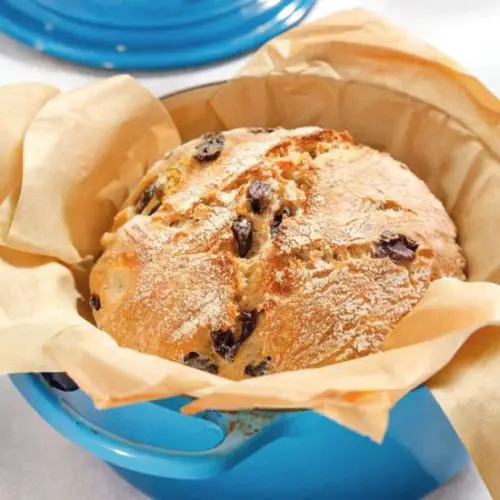
Olive Bread
This Mediterranean-inspired olive bread offers a crunchy crust and flavorful olive-studded crumb. Using a high-hydration dough and slow fermentation, it’s both approachable for beginners and rich in artisan taste.
Equipment
- 1 large mixing bowl
- 1 Dutch oven (6 to 8-quart)
- 1 dough scraper or rubber spatula
- Kitchen scale (optional but recommended)
- Parchment paper
- Tea towel (for second rise)
Ingredients
- 3 ½ cups 420g bread flour, plus extra for dusting
- 1 teaspoon kosher salt
- ¾ teaspoon instant yeast
- 1 ⅓ cups 320ml water, room temperature
- 1 packed cup 150g pitted olives, roughly chopped (mix Kalamata and green for best flavor)
- 1 tablespoon extra virgin olive oil
Instructions
- Combine Dry Ingredients and Olives: In a large bowl, whisk together the bread flour, kosher salt, and instant yeast until well blended. Stir in the chopped olives to distribute them evenly throughout the flour mixture.
- Add Liquids and Form Dough: Pour in the water and olive oil. Using a wooden spoon or sturdy spatula, mix until the dough forms and all the flour is hydrated. The dough will be sticky and somewhat loose—this is normal for a high-hydration bread.
- First Bulk Fermentation (Overnight Rise): Cover the bowl with plastic wrap or a clean kitchen towel and set it aside in a warm spot. Let the dough rest and rise slowly for 12 to 18 hours, until it has more than doubled in volume and is bubbly on the surface.
- Shape the Dough into a Round: Lightly flour your work surface and gently scrape the dough out of the bowl with a dough scraper or spatula. Without kneading, fold the dough onto itself a few times to create surface tension, then shape it into a loose ball.
- Second Proofing on Floured Towel: Generously dust a clean tea towel with flour. Place the dough seam-side down onto the towel. Loosely fold the towel over the dough and put it inside a large bowl or proofing basket. Let it rise for about 2 hours, until it nearly doubles in size.
- Preheat Oven and Dutch Oven: About 30 minutes before baking, place a clean Dutch oven (6 to 8-quart) on the lower oven rack and preheat your oven to 475°F (245°C). Heating the pot creates the ideal environment for a crusty loaf.
- Transfer Dough and Bake Covered: Carefully remove the hot Dutch oven from the oven using oven mitts. Use the floured towel or parchment paper to invert the dough into the pot. Cover with the lid and place it back in the oven. Bake for 30 minutes, allowing steam to develop inside.
- Bake Uncovered for Crust: Remove the lid and continue baking the bread for another 20 minutes or until the crust is deep golden brown and crisp.
- Cool Before Slicing: Lift the loaf out carefully with the parchment paper and place it on a wire rack. Let it cool completely before slicing to preserve the crumb’s texture.
Notes
- Handling Sticky Dough: This dough will feel wet and sticky. Avoid adding too much extra flour, which can dry out the bread. Instead, dust your hands and work surface lightly and use a dough scraper to manage the dough easily.
- Olive Variations: Use your favorite pitted olives. Combining Kalamata and green olives provides a nice balance of flavor and texture. Chop olives roughly to distribute flavor throughout the bread.
- Flour Alternatives: Bread flour is preferred for its gluten content and chewiness, but all-purpose flour can substitute without drastically changing the result. Up to half of the flour can be replaced with whole wheat for a denser, nuttier loaf.
- Yeast Options: Instant yeast works without needing to bloom. If you prefer using active dry yeast, dissolve it in about 1/3 cup warm water (100-115°F) for 5 minutes before adding to the dough, reducing total water by the same amount.
- Storage: Store leftover bread loosely covered at room temperature for up to 3 days. For longer storage, wrap cooled bread tightly in plastic and foil, then freeze for up to 3 months. Thaw at room temperature or overnight in the fridge.